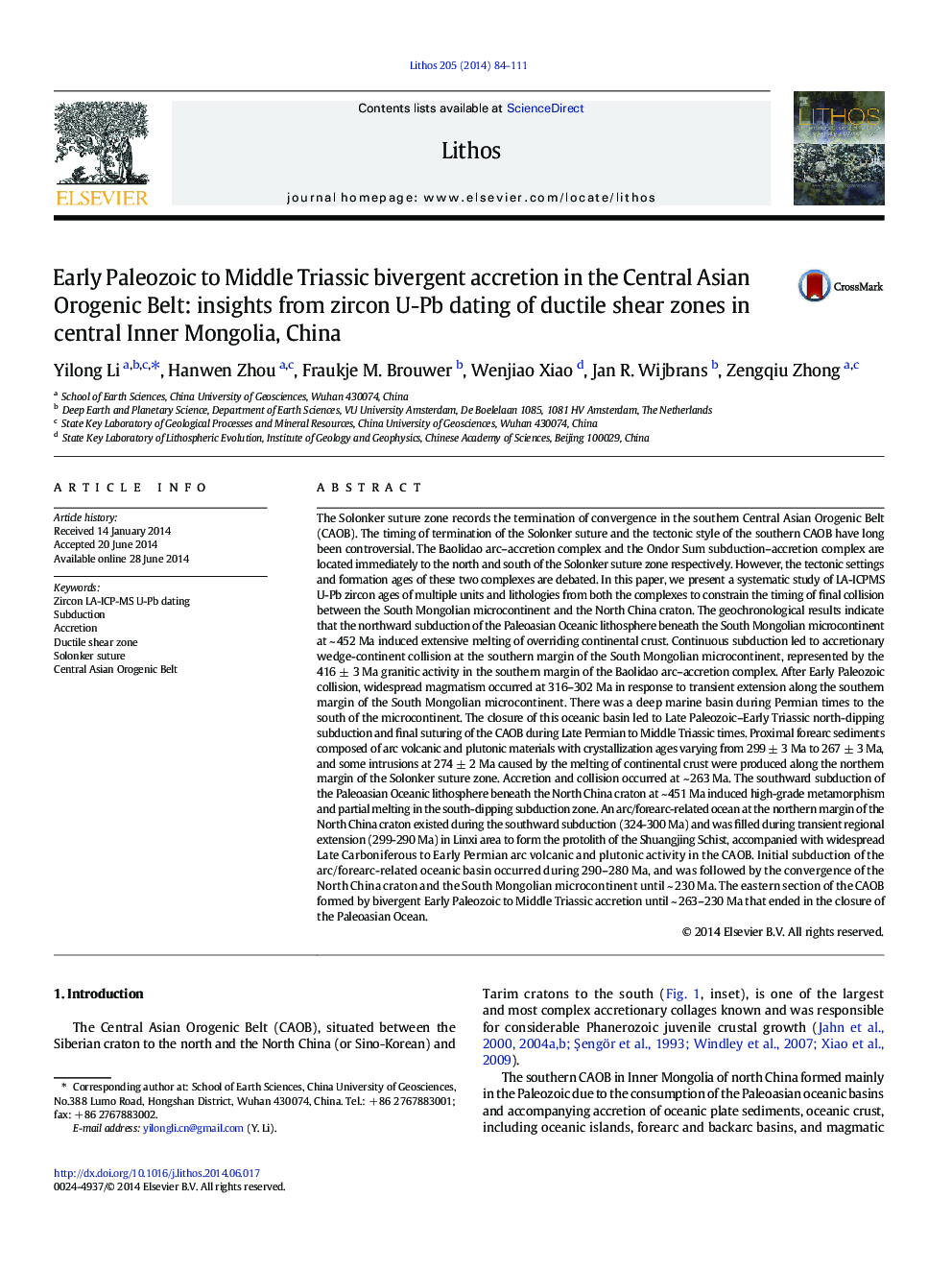| کد مقاله | کد نشریه | سال انتشار | مقاله انگلیسی | نسخه تمام متن |
|---|---|---|---|---|
| 4715828 | 1638673 | 2014 | 28 صفحه PDF | دانلود رایگان |

• The eastern CAOB formed by bivergent Early Paleozoic to Middle Triassic accretion.
• Late Carboniferous to Early Permian arc magmatism is widespread in the suture zone.
• There were arc/forearc-related basins during Permian times in the suture zone
• The closure of these basins led to final suturing of the CAOB until ~ 263–230 Ma.
The Solonker suture zone records the termination of convergence in the southern Central Asian Orogenic Belt (CAOB). The timing of termination of the Solonker suture and the tectonic style of the southern CAOB have long been controversial. The Baolidao arc–accretion complex and the Ondor Sum subduction–accretion complex are located immediately to the north and south of the Solonker suture zone respectively. However, the tectonic settings and formation ages of these two complexes are debated. In this paper, we present a systematic study of LA-ICPMS U-Pb zircon ages of multiple units and lithologies from both the complexes to constrain the timing of final collision between the South Mongolian microcontinent and the North China craton. The geochronological results indicate that the northward subduction of the Paleoasian Oceanic lithosphere beneath the South Mongolian microcontinent at ~ 452 Ma induced extensive melting of overriding continental crust. Continuous subduction led to accretionary wedge-continent collision at the southern margin of the South Mongolian microcontinent, represented by the 416 ± 3 Ma granitic activity in the southern margin of the Baolidao arc–accretion complex. After Early Paleozoic collision, widespread magmatism occurred at 316–302 Ma in response to transient extension along the southern margin of the South Mongolian microcontinent. There was a deep marine basin during Permian times to the south of the microcontinent. The closure of this oceanic basin led to Late Paleozoic–Early Triassic north-dipping subduction and final suturing of the CAOB during Late Permian to Middle Triassic times. Proximal forearc sediments composed of arc volcanic and plutonic materials with crystallization ages varying from 299 ± 3 Ma to 267 ± 3 Ma, and some intrusions at 274 ± 2 Ma caused by the melting of continental crust were produced along the northern margin of the Solonker suture zone. Accretion and collision occurred at ~ 263 Ma. The southward subduction of the Paleoasian Oceanic lithosphere beneath the North China craton at ~ 451 Ma induced high-grade metamorphism and partial melting in the south-dipping subduction zone. An arc/forearc-related ocean at the northern margin of the North China craton existed during the southward subduction (324-300 Ma) and was filled during transient regional extension (299-290 Ma) in Linxi area to form the protolith of the Shuangjing Schist, accompanied with widespread Late Carboniferous to Early Permian arc volcanic and plutonic activity in the CAOB. Initial subduction of the arc/forearc-related oceanic basin occurred during 290–280 Ma, and was followed by the convergence of the North China craton and the South Mongolian microcontinent until ~ 230 Ma. The eastern section of the CAOB formed by bivergent Early Paleozoic to Middle Triassic accretion until ~ 263–230 Ma that ended in the closure of the Paleoasian Ocean.
Journal: Lithos - Volume 205, 15 September 2014, Pages 84–111